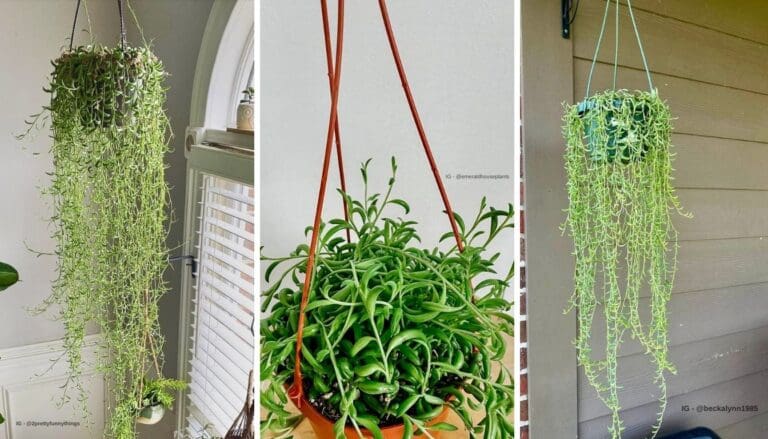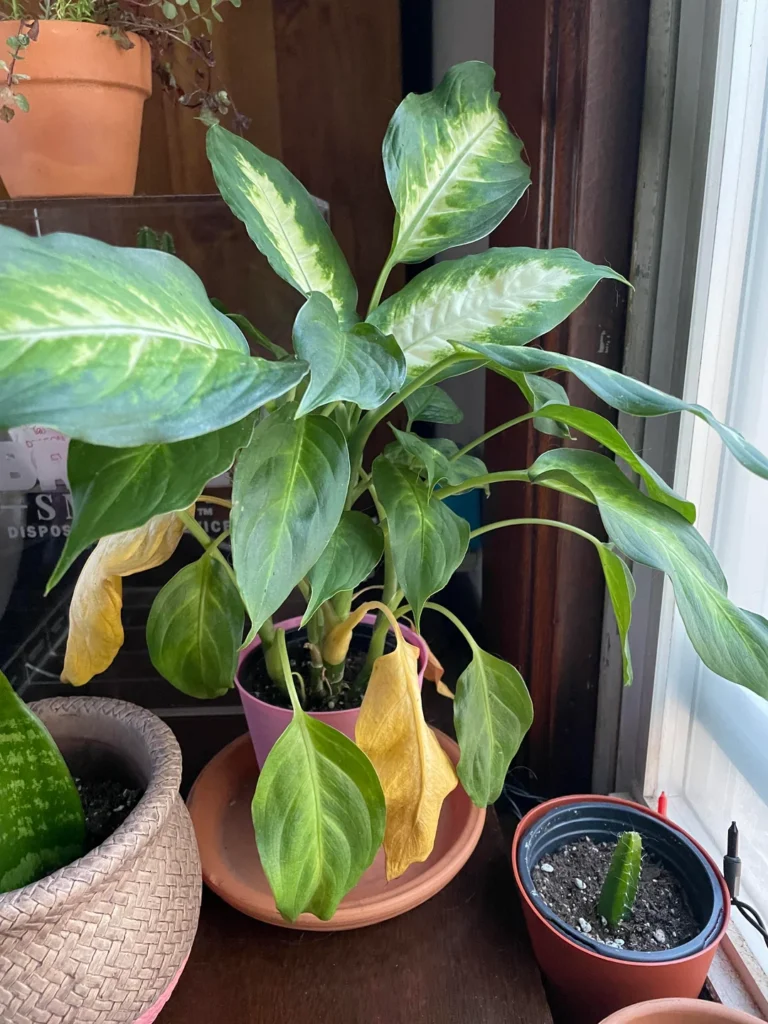11 Tips To Grow Lotus In Containers
I’ve always loved seeing lotus flowers bloom, even in small spaces. Growing them in containers lets me enjoy their calm beauty without needing a pond or a big yard.
You can actually put together a peaceful water garden right on your balcony, patio, or porch with just a few simple steps.
With the right container, soil, sunlight, and a bit of attention, lotus plants can thrive and bloom beautifully.
I’ll share practical tips that make it easy to keep them healthy, manage the water, and handle common issues like wind or pests.
This guide keeps everything simple so you can focus on enjoying your lotus plants.
Please note: Simplify Plants is reader-supported. As an Amazon Associate, I earn from qualifying purchases made by our readers with no extra cost added to you all! Some links in the post are affiliate links and I get a commission from purchases made through links in the post.
1) Choose a large container at least 18 inches wide
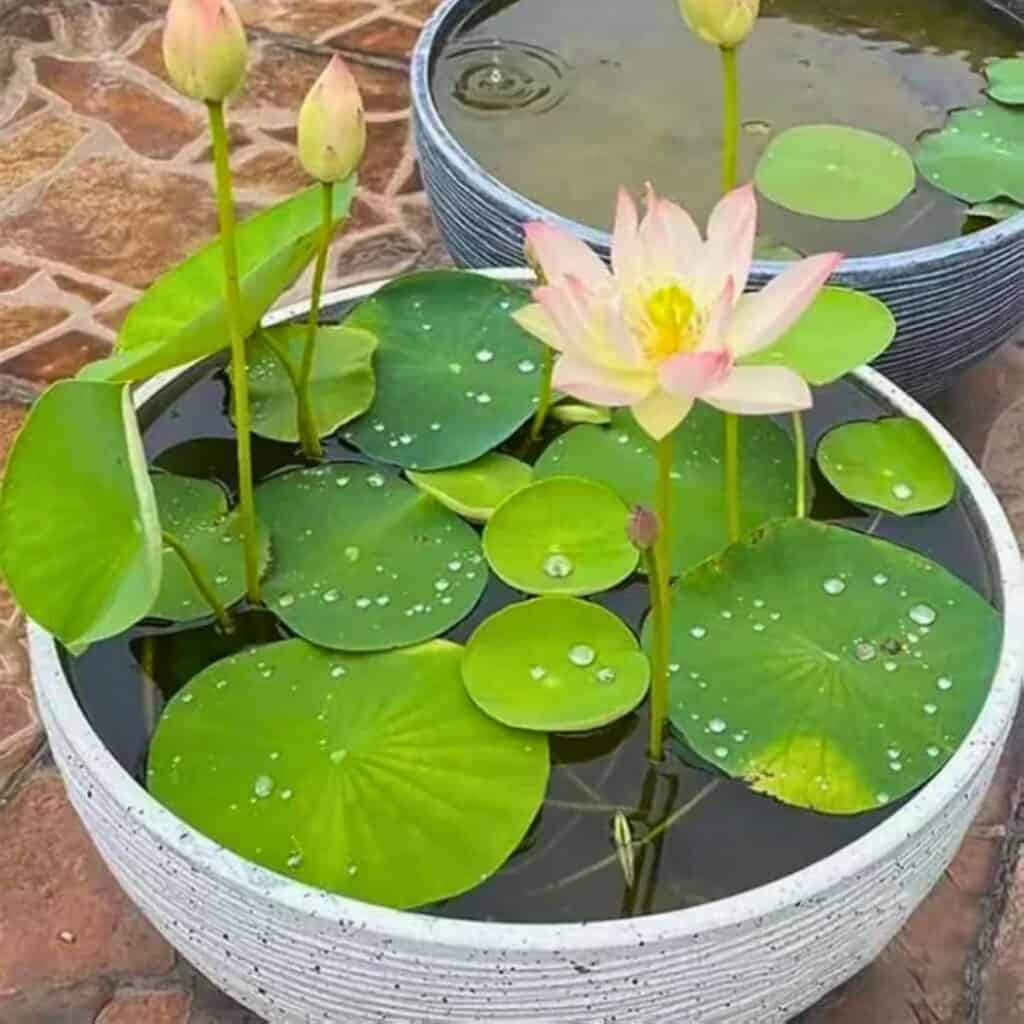
I always start by picking a large container because lotus plants need space for their roots to spread. A pot that’s at least 18 inches wide gives the plant enough room to grow strong and healthy.
Personally, I like containers that are wide and shallow instead of deep. Lotus roots don’t really go downward—they like to stretch out sideways.
This shape also keeps the water level more stable, which is surprisingly important for healthy growth.
Using a non-draining container works best for lotus. Holes in the bottom can let water escape and mess with the roots.
I make sure the container can hold water without leaking. For materials, I usually go with plastic, clay, or ceramic pots—they’re sturdy and hold moisture well.
If I’m reusing an old container, I give it a good scrub first to remove any dirt or residue that might harm the plant.
A dark-colored container helps warm the water faster in spring, which encourages early growth. But honestly, in really hot areas, I sometimes go with a lighter color so the water doesn’t get too warm.
When setting up the container, I leave a few inches of space at the top for water. This helps prevent overflow and keeps the soil from washing away.
It also makes it easier to adjust the water level later, which, trust me, comes in handy.
Choosing the right size container at the start saves me time and effort later. The lotus can grow freely and stay healthy through the season.
2) Use heavy clay soil for planting
I always choose heavy clay soil when I plant lotus in containers. It’s dense and helps anchor the roots so the plant stays upright.
Loose or sandy soil can let the tubers float, which just isn’t ideal for growth. Clay soil also holds nutrients and moisture better than lighter mixes.
Lotus plants need steady access to both, especially when it’s warm out. I make sure the soil feels firm but not bone dry or cracked.
Before planting, I check that the soil is free of fertilizers or chemicals. These can actually harm new shoots.
I like using natural pond clay or mixing regular garden clay with a bit of compost for gentle nutrition. When I fill the container, I leave a few inches at the top for water.
Then I press the tuber gently into the clay so it sits flat. I cover it lightly, just enough to keep it in place.
As the lotus grows, the clay helps keep the water clear by reducing floating particles. It also prevents the tuber from moving if fish or wind disturb the container.
Heavy clay gives lotus plants a stable base and steady growth, helping them produce strong leaves and healthy blooms.
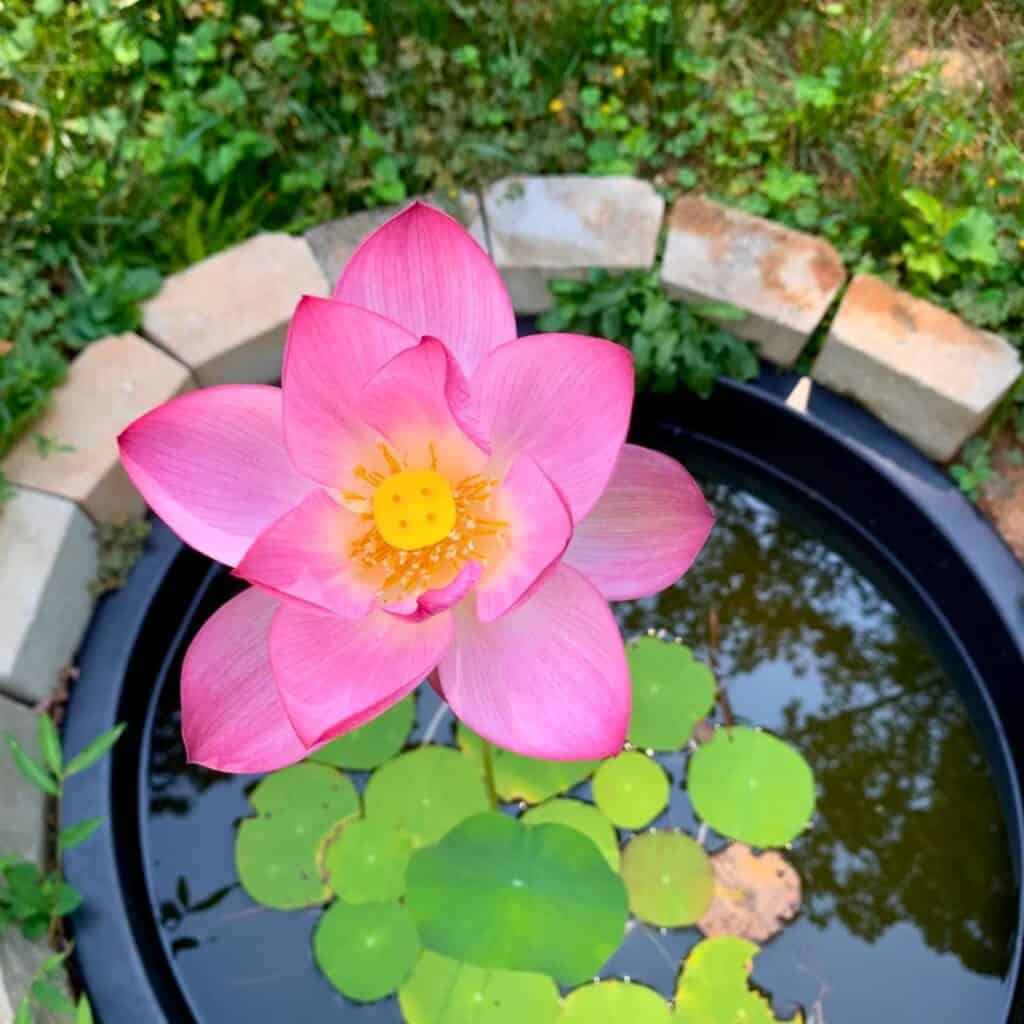
3) Plant lotus tubers horizontally
When I plant my lotus, I always lay the tubers flat instead of standing them upright. This helps the new shoots grow evenly and prevents the tuber from rotting.
I place the tuber gently on top of the soil in the container, keeping the growing tips just above the surface. I’m careful not to bury them too deep because that can block the shoots from reaching the light.
The growth tips are delicate, so I handle them carefully. If one breaks, well, it might stop growing altogether.
I press the tuber lightly into the soil to keep it steady but never force it down. I cover the tuber with just a thin layer of soil, about an inch or less.
Then I add water slowly to avoid disturbing its position. The water should be clear enough for sunlight to reach the plant.
Keeping the tuber horizontal lets the roots spread and anchor well. This simple step gives the lotus a strong start and helps it grow healthy leaves and flowers later.
4) Place containers in full sunlight for 6+ hours daily

I always make sure my lotus containers sit where they get at least six hours of direct sunlight every day. Lotus plants love warmth and light, and they really do best when exposed to full sun.
Without enough sunlight, the leaves may stay small, and the flowers might not bloom at all. I notice my lotus grows faster and produces more blooms when I place it in a bright, open area.
A sunny patio, balcony, or garden spot usually works. If I keep the container in partial shade, the plant gets weak and loses color.
Sunlight also helps keep the water warm, which is important for healthy roots. I check that no trees or walls block the light during the day.
Even a bit of shade can slow things down. When I move containers outdoors in spring, I start by giving them morning sun and then full sun as the weather warms.
This helps the plant adjust without a lot of stress. If I’m growing lotus indoors, I set it near a south-facing window or use a grow light to give it enough brightness.
The goal’s always the same—steady, strong sunlight for healthy leaves and flowers. Keeping my lotus in full sun makes a huge difference.
The leaves stay green, the blooms open wide, and the plant just looks lively all season.
5) Keep water level 2-4 inches above soil
I always make sure the water level stays about 2 to 4 inches above the soil in my lotus container. This little detail really makes a difference in how healthy the plant grows.
When the water is too low, the soil can dry out and stress the roots. If it’s too high, young leaves might have trouble reaching the surface.
I check the water level every few days, especially when it’s hot outside. Evaporation can lower the water quickly, so I top it up with clean water when needed.
I try to use dechlorinated or rainwater because tap water with chlorine can harm the plant over time. Letting tap water sit out overnight usually works fine.
As the lotus grows taller and stronger, I sometimes raise the water level a bit. But I always make changes slowly so I don’t shock the plant.
Consistent water depth helps the lotus form healthy leaves and buds. It also keeps the roots cool and the soil moist without being muddy.
I’ve noticed that keeping the water clear also helps prevent algae and pests. A stable water level just supports that balance naturally.
This simple habit—checking and adjusting the water depth—keeps my lotus thriving all season long.
6) Fertilize monthly with aquatic plant fertilizer

I make sure to feed my lotus once a month using an aquatic plant fertilizer. This keeps the plant strong and helps it grow healthy leaves and flowers.
Without enough nutrients, the lotus may look weak or stop blooming. I prefer slow-release fertilizer tablets because they feed the plant over time.
I push the tablet gently into the soil near the base of the plant. This way, the nutrients reach the roots where they’re needed most.
When I use liquid fertilizer, I follow the label instructions carefully. Too much fertilizer can harm the plant or cause algae to grow in the water.
I always measure the right amount before adding it to the container. I notice that fertilizing regularly makes a big difference.
The leaves stay green, and the flowers open wider and last longer. If I skip a month, I can tell the plant loses some of its energy.
During the colder months, when the lotus rests, I stop fertilizing. The plant doesn’t need extra food while it’s dormant.
Once new growth appears in spring, I start the monthly feeding again.
7) Change water regularly to prevent stagnation
I always make sure to change the water in my lotus container every week. Fresh water keeps the plants healthy and stops algae or bad smells from forming.
Stagnant water can harm the roots and attract pests like mosquitoes. When I change the water, I remove only part of it, about one-third to half, instead of draining the whole container.
This helps keep some beneficial bacteria that support the lotus roots. I then add clean, chlorine-free water at room temperature.
I’ve noticed that clear water helps the leaves stay bright and strong. Dirty or still water can block sunlight and slow the plant’s growth.
Regular water changes also prevent buildup of waste or fertilizer residue. If I see the water turning green or cloudy, I don’t wait for my next schedule—I change it right away.
By keeping the water clean, I give my lotus the best chance to grow healthy leaves and beautiful blooms.
8) Protect from strong winds with a windbreak
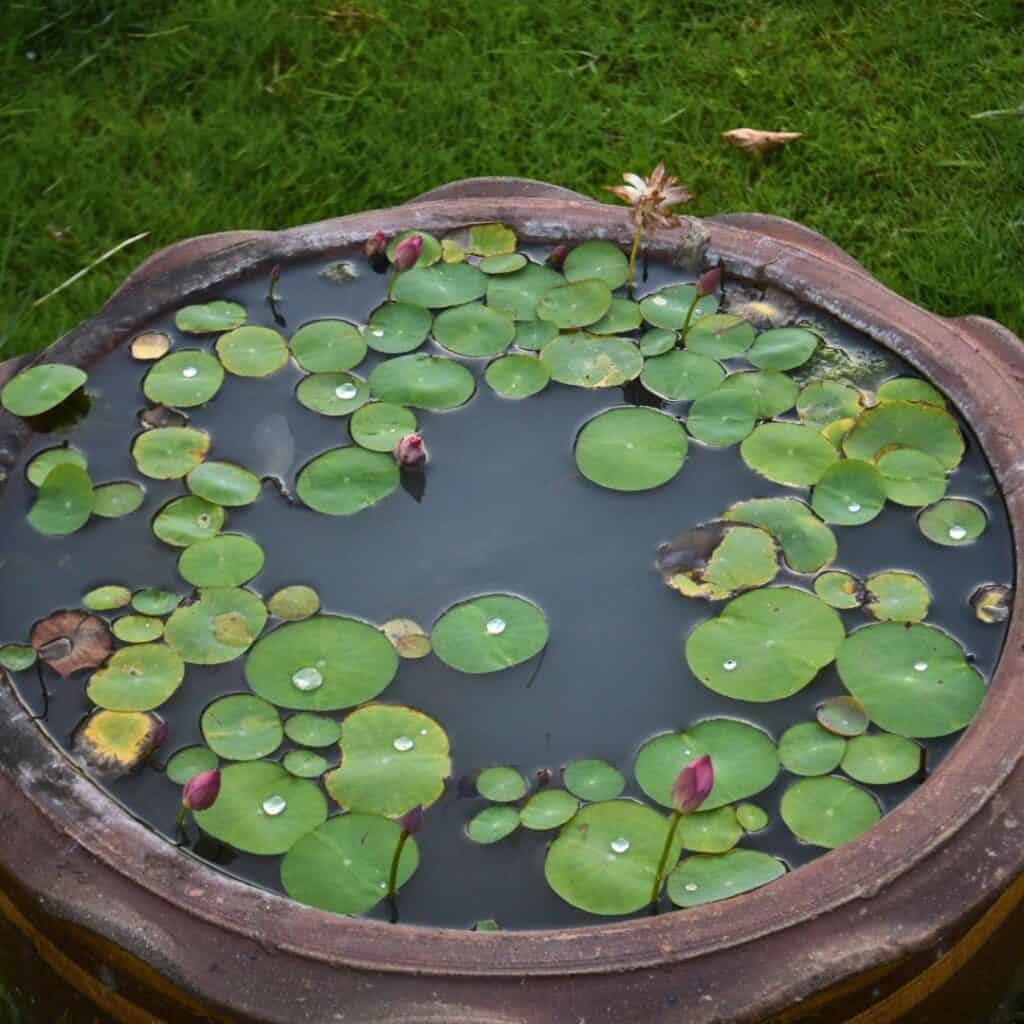
I’ve learned that strong winds can easily damage lotus leaves and flowers. The large leaves act like sails, catching the wind and tearing if they aren’t protected.
That’s why I always make sure to block harsh gusts around my containers. I like to place my lotus pots near a fence, wall, or hedge that breaks the wind.
These barriers slow the air and keep the plants from bending or snapping. Even a balcony railing or garden screen can make a big difference.
If I don’t have a natural barrier, I create one. I sometimes use bamboo screens or lattice panels to shield my containers.
They look nice and still let in some air and light, which keeps the plants healthy. I also avoid placing lotus containers in narrow spaces where wind tunnels form.
Sheltered corners or patios work better because they reduce direct wind exposure. When I expect a storm or strong breeze, I move smaller containers to a safer spot.
It’s a simple step that helps keep the leaves and buds from breaking. Protecting lotus from wind doesn’t take much effort, but it keeps the plants looking neat and growing well.
9) Remove yellowing leaves promptly
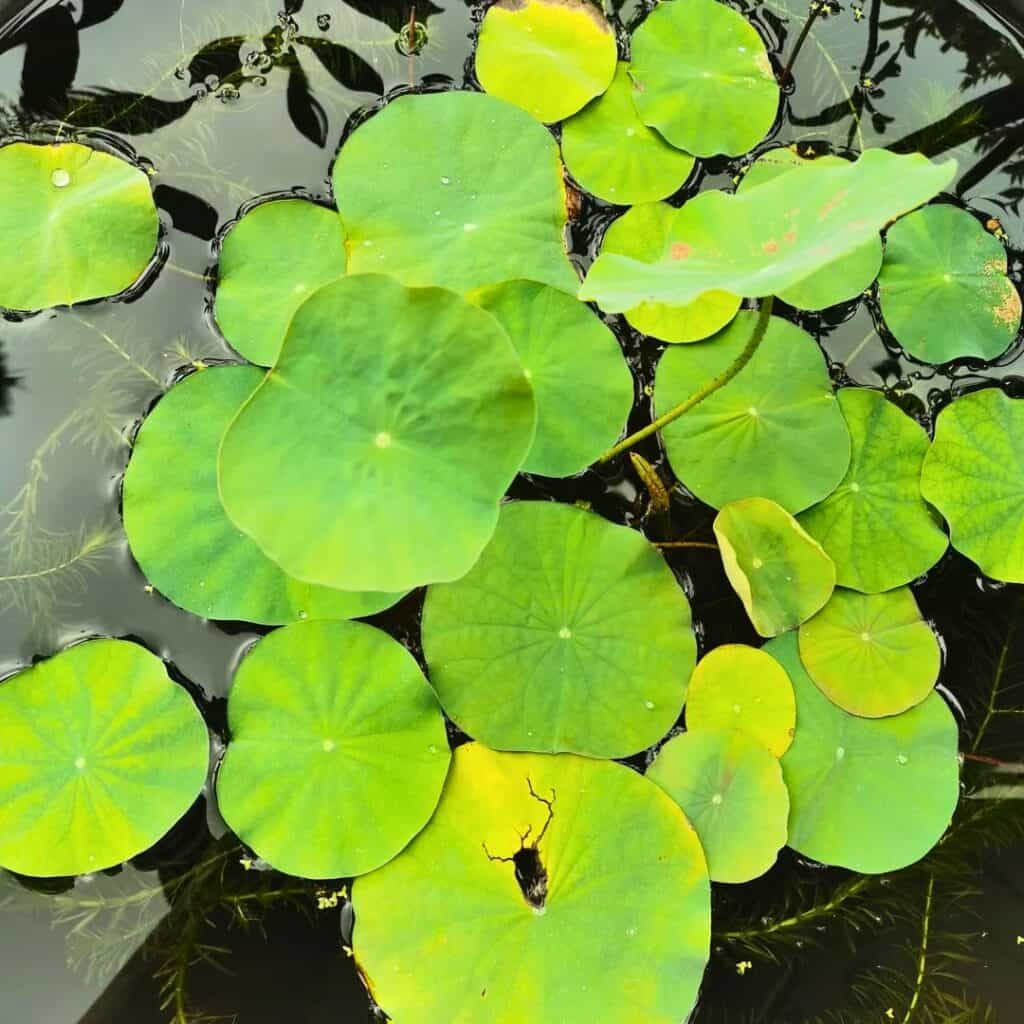
I always check my lotus leaves often because yellowing can spread fast. When I spot a leaf turning yellow, I remove it right away.
This keeps the plant looking neat and helps it stay healthy. Yellow leaves often mean the leaf is old or not getting enough light.
Sometimes, it can also signal nutrient imbalance or poor water quality. By trimming these leaves, I help the plant focus its energy on new growth.
I use clean scissors or garden shears to cut the yellow leaf near the base. I’m careful not to damage nearby stems or healthy leaves.
Clean tools help prevent infection or rot in the container. Leaving yellow leaves in the water can cause them to decay and pollute the container.
This can lead to algae growth or unpleasant smells. I make it a habit to inspect my lotus every few days, especially during warm months when growth is fast.
10) Divide tubers every 2-3 years
Honestly, I’ve found lotus plants are so much happier when I divide their tubers every 2-3 years. It’s not hard, and it keeps them healthy with room to grow.
If I skip it, things get crowded fast, and suddenly there are fewer blooms. Who wants that?
I like to divide the tubers in early spring, just before new growth kicks in. The weather’s mild, which seems to help the plant bounce back.
I gently lift the tubers from the container and rinse off the soil so I can actually see what’s going on with the roots.
I’m always on the lookout for firm, healthy tubers with at least one growing tip. Any mushy or rotting bits go straight to the compost—no second chances.
When I cut the healthy tubers apart, I make sure each piece has a tip and a bit of root. It’s a little fiddly but worth it.
Afterward, I replant each tuber in fresh soil, leaving plenty of space for them to stretch out. I start with a shallow water level so the new shoots can reach the surface.
As they grow stronger, I slowly raise the water. No rush—just a little at a time.
Dividing tubers is also my favorite way to propagate new lotus plants. Sometimes I hand extras to friends or start another pot for myself.
Honestly, it’s a pretty easy way to grow your collection without spending more money.
The tubers are delicate, so I try to handle them gently. Bruised tips don’t grow well, so I take it slow and easy.
A bit of care now pays off big time later in the season.
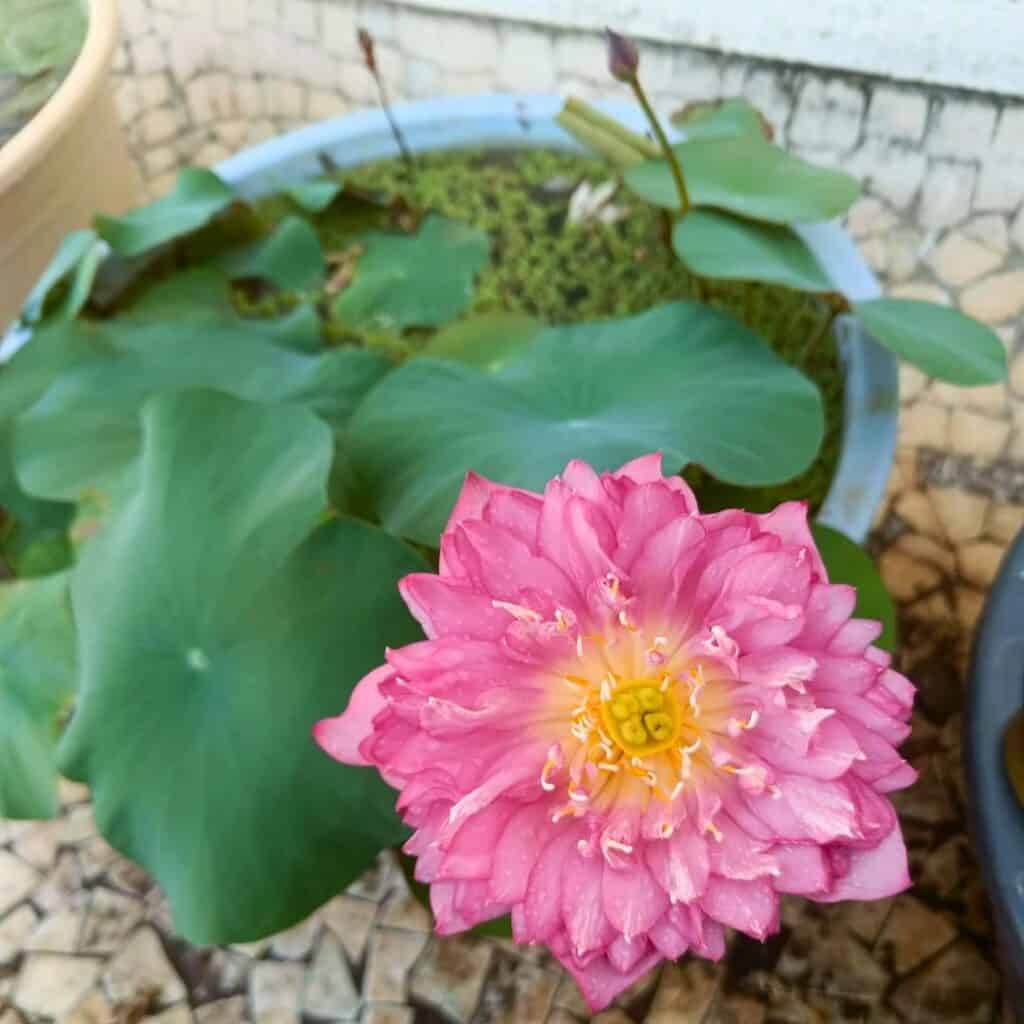
11) Use mosquito dunks to control larvae
Keeping my lotus containers free of pests is a must. Mosquito dunks make it simple—they stop mosquito larvae without hurting the plants or anything else living nearby.
They’re safe for fish, pets, and people, so I don’t have to worry. That’s a relief, honestly.
Once a month, I just drop a dunk into the water. It slowly releases Bacillus thuringiensis israelensis (Bti), a natural bacteria that targets mosquito larvae but leaves everything else alone.
If the water level changes a lot, I check to make sure the dunk is still in there. Sometimes I swap it out early if I’ve had to refill the water more often than usual.
Since I started using mosquito dunks, there are way fewer mosquitoes around my patio.
It’s a tiny step that makes a big difference for my comfort and the health of the water.
Using mosquito dunks is honestly one of the easiest ways to protect lotus plants and keep the area pleasant for everyone.
Choosing the Right Container
I’ve realized over time that the container you pick really does shape how well your lotus grows. Size and material matter—they keep the plant sturdy, healthy, and pretty easy to manage.
Container Size Considerations
I always go for a wide, shallow container since lotus roots like to spread out sideways, not down. A pot that’s at least 18–24 inches wide gives them enough room to stretch.
Depth matters too, but usually 10–12 inches is plenty for most types.
Small containers dry out fast and stunt growth, while big ones hold more water and nutrients. I steer clear of tall, skinny pots—they just make life harder for the plant.
Tip: I always leave about 2 inches of space at the top so the water doesn’t spill over when I add soil or fertilizer.
Best Materials for Lotus Containers
My go-to is non-porous materials like plastic, fiberglass, or glazed ceramic. They hold water well and don’t leak nutrients.
Porous pots like unglazed clay or terracotta dry out way too fast and can crack.
Plastic tubs are lightweight and easy to move, which is handy if I need to chase the sun or shade. Glazed ceramic pots look gorgeous, but they’re heavy—once they’re set, they’re not going anywhere.
Metal containers heat up super fast in the sun, which isn’t great for roots. Unless there’s a liner, I avoid them.
I like dark-colored containers because they soak up warmth and help the lotus get going earlier in the year.
Water Quality and Maintenance
I keep an eye on water quality because it makes all the difference. Clean, balanced water helps the roots thrive and wards off issues like algae or stunted growth.
Testing and adjusting the water regularly just gives my plants a better shot at being their best.
Balancing pH Levels
I’ve noticed lotus plants are happiest when the pH sits between 6.5 and 7.5. That’s the sweet spot for nutrients and healthy roots.
I use a basic pH testing kit once a week to keep things steady.
If the pH drops, I add a pinch of crushed limestone or sometimes a little baking soda. If it creeps up, I’ll use rainwater or a splash of white vinegar.
I always make tiny changes and check again after a few hours—no sense in rushing it.
Tap water with a lot of chlorine or fluoride isn’t great. Letting it sit out for a day helps those chemicals fade away.
Balanced pH really does keep the leaves greener and flowers brighter.
Preventing Algae Growth
Algae can be a pain, so I try to limit sunlight and extra nutrients in the water. Too much fertilizer or direct sun, and algae goes wild.
I put my container where it gets 4–6 hours of sunlight a day—not full sun all day long.
A few floating plants like water lettuce help shade the surface and hog the nutrients, so algae doesn’t win.
Every few weeks, I gently clean the container walls to stop buildup.
If algae keeps coming back, I’ll swap out about a third of the water and rinse the container lightly.
I steer clear of harsh chemicals—they’re just not worth the risk to the lotus roots.
Clear water really helps the lotus stay strong and bloom better.
Frequently Asked Questions
I’ve realized that container size, sunlight, water temperature, soil quality, and placement all play a big role in how well lotus plants grow. Paying attention to these details keeps the plants healthy and blooming.
What type of container is best for growing lotus?
I use a large, wide container that’s at least 18 inches across and has no drainage holes. This helps the lotus roots spread easily and keeps water from leaking out.
How much sunlight do lotus plants need to thrive?
My lotus plants do best in full sunlight for at least 6 hours a day. Without enough light, the leaves may stay small and flowers might not form.
What is the ideal water temperature for lotus in containers?
I keep the water between 75°F and 87°F (24°C–31°C). Cooler water slows growth, while very hot water can stress the plant.
How often should I change the water in my lotus container?
I don’t change the water often. Instead, I top it off as it evaporates to keep the level 2–4 inches above the soil. If the water smells bad or looks dirty, I replace part of it gently.
What kind of soil mixture is recommended for container-grown lotus?
I use heavy clay soil because it anchors the tubers and prevents floating. I avoid potting mix or sandy soil since they make the water cloudy.
Can I grow lotus indoors using containers, and if so, how?
Absolutely, you can grow lotus indoors if you’ve got a container and a spot with lots of sunlight. Just put it near a sunny window, or maybe under some strong grow lights if your place doesn’t get much natural light.
It’s important to keep the room warm, too—lotus plants really don’t like the cold. Make sure they get plenty of light every day, and you’ll have a good shot at seeing those gorgeous blooms.
Recommended Garden Supplies
| Product Image | Our Recommended Gardening Supplies | Check Offers! |
|---|---|---|
Top Top
Top
Top
Top
Top
Top
Top
Top | rePotme Houseplant and Tropical Classic Potting Soil Mix | Check Offer On Amazon |
 Top
Top
Top
Top
Top
Top
Top
Top | Espoma Organic Indoor Plant Food | Check Offer On Amazon |
 Top
Top
Top
Top
Top
Top
Top
Top | GooingTop LED Grow Light 6000K Full Spectrum Clip Plant Growing Lamp | Check Offer On Amazon |
 Top
Top
Top
Top
Top
Top
Top
Top | Soil Moisture Meter | Check Offer On Amazon |
 Top
Top
Top
Top
Top
Top
Top
Top | Govee Hygrometer Thermometer, Bluetooth Enabled! | Check Offer On Amazon |
 Top
Top | LEVOIT Humidifiers for Large Room(Best For Plants) | Check Offer On Amazon |
 Top
Top
Top
Top
Top
Top
Top
Top | Upgraded DIY Automatic Drip Irrigation Kit, 15 Potted Houseplants Support | Check Offer On Amazon |
 Top
Top
Top
Top
Top
Top
Top
Top | Stainless Steel Heavy Duty Gardening Tool Set | Check Offer On Amazon |
 Top
Top
Top
Top
Top
Top
Top
Top | Bonide Insecticidal Soap | Check Offer On Amazon |
 Top
Top
Top
Top
Top
Top
Top
Top | Bonide 32 oz Spray Neem Oil for Organic Gardening | Check Offer On Amazon |
 Top
Top
Top
Top
Top
Top
Top
Top | Garden Safe Fungicide | Check Offer On Amazon |
Note: Some images in the articles are sourced from Reddit and Other Platforms For Reference Purpose.


